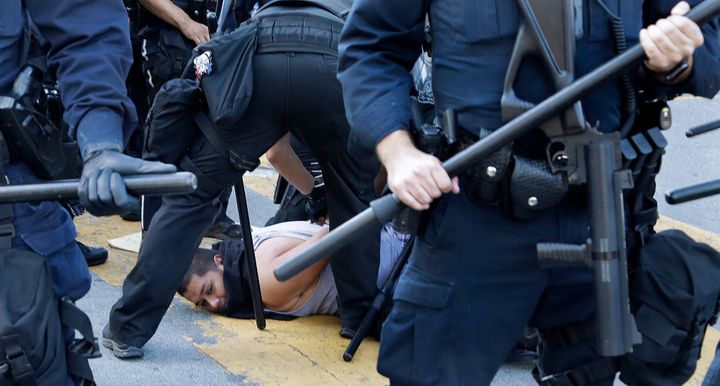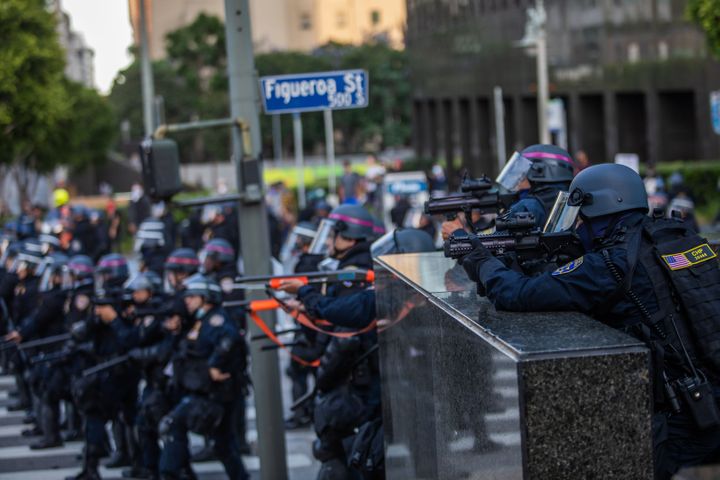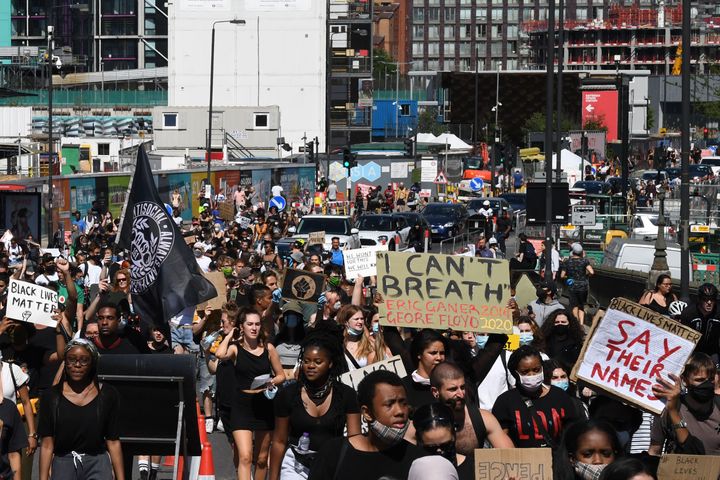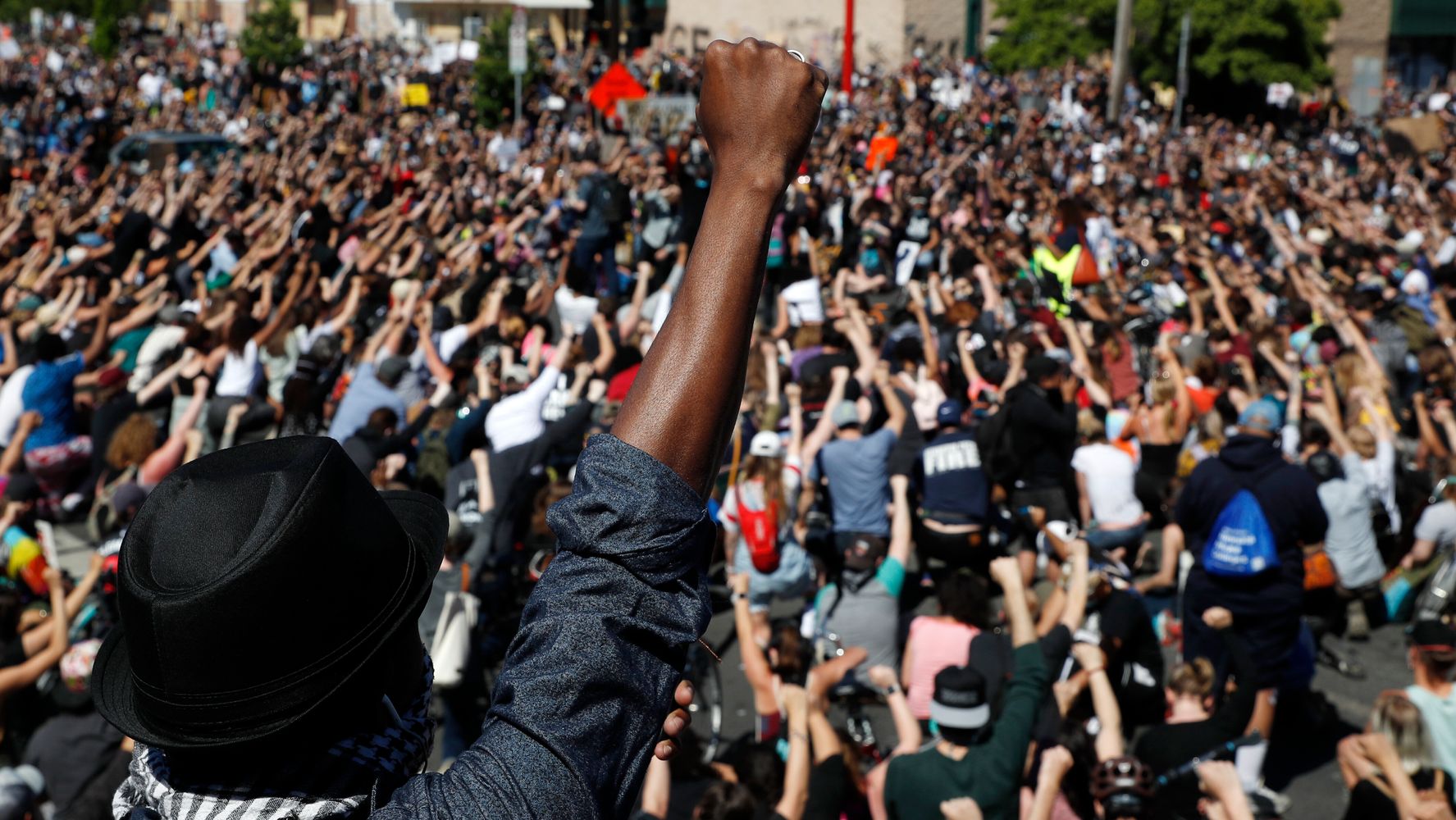[ad_1]
Protests prompted by the police killing of George Floyd popped up in even more cities across the U.S. on Saturday as tens of thousands of people continued to demand justice for Black victims of police brutality, and in many cities they were met with increasingly heavy-handed police crackdowns.
By late Saturday, at least 25 cities across 16 states had imposed curfews in response to the demonstrations, CNN reported. Several cities ordered curfews to go into effect again on Sunday night.
Large swaths of people gathered on the streets of Austin, Texas; Chicago; Columbus, Ohio; Denver; Fayetteville, North Carolina; Indianapolis; Los Angeles; Miami; New York City; Newark, New Jersey; Philadelphia; Salt Lake City; San Francisco; Washington, D.C. and more on the warm weekend day.

As night fell, tensions increased in numerous cities. Police in Indianapolis said they were investigating multiple shootings downtown where protests had turned violent. At least one person had been killed and several people were injured in the shootings, said Randal Taylor, the Indianapolis Metropolitan Police Department chief.
“Enough is enough. Indianapolis, we are better than this,” Taylor said, adding the downtown area was “not safe at this time.”
At least 13 police officers in Philadelphia were injured when demonstrations became violent, The New York Times reported.

The National Guard said early Sunday that approximately 5,000 of its soldiers and airmen had been deployed “in response to civil disturbances” in 15 states and the nation’s capital, with “another 2,000 prepared to activate if needed.” Nevada, North Dakota, Georgia, Texas, Ohio, and Kentucky were among the states that called in the National Guard.
The Pentagon ― in an extraordinary move ― said it had also put military units on a four-hour alert to be ready if Minnesota’s governor requested assistance.
In numerous cities, police employed brutal tactics. In Brooklyn, a police SUV drove through a crowd standing around a blockade, knocking several people backward, as seen in a video filmed from a building.
Another video, apparently filmed from a different angle, shows protesters throwing plastic bottles and traffic cones at a police vehicle before a second vehicle arrives and drives through the group of people.
Earlier in Brooklyn, protesters set fire to a dumpster and at least two police vehicles. Police tried to keep groups of protesters separated from each other and were seen arresting people, according to HuffPost’s Christopher Mathias, who was reporting from the scene and was later arrested while reporting.
Mathias is one of several journalists who has been arrested or harassed while covering the weekend’s protests. Linda Tirado, a freelance photographer, said she was left permanently blind in one eye after a rubber bullet shot by police hit her in the face in Minneapolis on Friday. Protesters in D.C. attacked a Fox News correspondent and his crew; and crowds of demonstrators vandalized CNN’s headquarters in Atlanta on Friday.
Los Angeles Times reporter Molly Hennessy-Fiske said Saturday that she and other journalists were injured by rubber bullets after being shot at by Minneapolis police.
“I’ve covered protests involving police in Ferguson, Mo., Baton Rouge, La., Dallas and Los Angeles. I’ve also covered the U.S. military in war zones, including Iraq and Afghanistan. I have never been fired at by police until tonight,” Hennessy-Fiske said.
Video taken by Vice News correspondent Michael Anthony Adams shows police pepper-spraying him in the face as he is lying on the ground and identifying himself as press. Journalist and NBC News contributor Simon Moya-Smith also said he was pepper-sprayed and then arrested by Minneapolis police after identifying himself as a reporter.
In Nashville, Tennessee, protesters began to disperse once a smoke bomb went off after nightfall on Saturday at an “I Will Breathe” demonstration, where some had set fires and smashed windows in City Hall and a courthouse.
Police in several cities, including Minneapolis; Richmond, Virginia; and Orlando, Florida, used tear gas and other projectiles to scatter protesters. One video posted to Twitter appeared to show the National Guard in Minneapolis intentionally shooting people on their front porch with paint canisters. The state’s curfew does not forbid people from being outside their house, on their property, after hours.
In Denver, police fired canisters of tear gas to disperse crowds soon after a curfew went into effect in the city on Saturday night.
In an attempt to quell protests overnight, cities implemented curfews to get demonstrators to clear the streets and give law enforcement power to crack down. In Los Angeles and Chicago, anyone out after 9 p.m. could be arrested for violating curfew, officials said.
But a number of curfews were announced shortly before they went into effect — giving people insufficient time to comply with the orders. In Seattle, the curfew went into effect 14 minutes after it was announced Saturday. Chicago’s curfew was announced with just 20 minutes’ notice.
According to The New York Times, the imposition of curfews across the country on Saturday appeared to be “more widespread than at any time since the aftermath of the assassination of Martin Luther King Jr. in 1968.”
At many of Saturday’s demonstrations, protesters chanted and held signs, repeating the words that Floyd, 46, uttered as a Minneapolis police officer kneeled on his neck for over eight minutes: “I can’t breathe.”
Morgan Davis, a 29-year-old Los Angeles resident, told HuffPost she came out to protest on Saturday because she is tired of Black people, including herself, being “terrorized.”
“I came out today because for too long, people who look like me have been terrorized for no reason except [for] our skin color, and enough is enough,” she said. “I shouldn’t be afraid to die just because I exist.”
Hundreds of people turned out in Salt Lake City. In Washington, D.C., hundreds of protesters gathered near the White House as police attempted to hold them back. Hundreds of people in Fayetteville came out for two separate protests.
In Salt Lake City, a police car was overturned and spray-painted, and in Cleveland, a local reporter took a video of two police cars on fire.
In Los Angeles on Saturday afternoon, protesters moved aside to let an ambulance pass and cheered as the driver sounded the siren. Some protesters paused their march to dance in the streets.
“It feels like there are more things that connect us than separate us. A lot of times people try and divide us by what we look instead of seeing the human in us,” Davis told HuffPost in a text message during the protests in Los Angeles.
She added later: “It’s time for people to collectively do the right thing by each other and end racism for good.”
Protests weren’t limited to American cities over the weekend. There were similar demonstrations in Berlin, London and Toronto. Videos posted to social media showed protesters marching with signs and chanting, “Black lives matter.”
In the U.S., protests have given rioters an opportunity to burn buildings and turn violent. For law enforcement, determining the proper response to unrest is an extremely difficult and dangerous task. A federal protective service officer was killed in Oakland, California, on Friday, and other officers have been injured.
But there have also been countless instances of overreach and abuse by police, especially concerning the use of less-lethal projectiles, such as rubber bullets. Numerous videos have circulated of police firing rubber bullets and violently arresting protesters who clearly posed no threat. According to an AP News tally, at least 1,669 people in 22 cities have been arrested since Thursday.
After the unrest in Ferguson, Missouri, in 2014, the Justice Department commissioned an after-action report to evaluate the response of law enforcement officers. The report stated that less-lethal munitions could be warranted in many protest situations, but that officers should take care not to use those weapons against citizens simply exercising their constitutional rights and choose a course of action that is not just authorized, but “is right.”

Former Minneapolis police Officer Derek Chauvin, the officer who knelt on Floyd’s neck as Floyd struggled for breath, was charged with third-degree murder and second-degree manslaughter on Friday, but the other three officers have not been charged.
President Donald Trump on Saturday claimed that anti-fascist activists and “left-wing groups” were responsible for the violence at the protests.
“The violence is being led by antifa and other left-wing groups who are terrorizing the innocent, destroying jobs, hurting businesses and burning down buildings,” he said at a press conference.
“Radical left criminals, thugs and others, all throughout our country and throughout the world, will not be able to set communities ablaze,” Trump said. “The leadership of the National Guard and the Department of Justice are now in close communication with state and city officials in Minnesota and we’re coordinating with local law enforcement.”
At a later speech on Saturday, Trump offered a more reserved statement.
“We support the right of peaceful protesters, and we hear their pleas,” he said. “But what we are now seeing on the streets of our cities has nothing to do with justice or peace.”
This post has been updated throughout. Nina Golgowski and Ryan J. Reilly contributed to this report.
Calling all HuffPost superfans!
Sign up for membership to become a founding member and help shape HuffPost’s next chapter
[ad_2]
Source link

